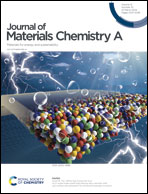Constructing plasmonic electron acceptors on TiO2 for full-spectrum-driven photocatalytic hydrogen generation†
Abstract
Doped semiconductors have emerged as promising plasmonic nanomaterials for photocatalysis due to their unique combination of metal-like and semiconductor properties. A key scientific challenge to develop plasmonic semiconductors is to significantly increase the intrinsically low free electron density in semiconductors. Herein, we fabricated W-doped TiO2 nanodots (WTO-NDs) as plasmonic electron acceptors on the surface of TiO2 nanosheets (TO-NSs), creating a novel plasmonic isotype heterostructure of WTO-NDs/TO-NSs for full-spectrum-driven photocatalytic hydrogen generation. Surface W-doping provided an obvious localized surface plasmon resonance in the visible-NIR region to the heterostructure, which also offered more active reaction sites. The photoexcited electrons from TO-NSs can be efficiently transferred to WTO-NDs, resulting in a high electron density on the heterostructure surface and boosting hot electron generation for photocatalysis. The optimized WTO-NDs-1/TO-NS heterostructure exhibited an impressive hydrogen generation of 51.03 mmol g−1 within 3 h under UV-visible-NIR irradiation, surpassing the performance of individual TO-NSs and WTO-NDs. This work provides a new strategy for constructing plasmonic semiconductors with high surface free electron concentration for full-spectrum photocatalysis.



 Please wait while we load your content...
Please wait while we load your content...